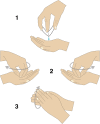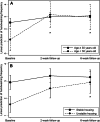A two-component intervention to improve hand hygiene practices and promote alcohol-based hand rub use among people who inject drugs: a mixed-methods evaluation
- PMID: 33632143
- PMCID: PMC7905764
- DOI: 10.1186/s12879-021-05895-1
A two-component intervention to improve hand hygiene practices and promote alcohol-based hand rub use among people who inject drugs: a mixed-methods evaluation
Abstract
Background: Inconsistent hand hygiene puts people who inject drugs (PWID) at high risk of infectious diseases, in particular skin and soft tissue infections. In healthcare settings, handwashing with alcohol-based hand rubs (ABRH) is recommended before aseptic procedures including intravenous injections. We aimed to evaluate the acceptability, safety and preliminary efficacy of an intervention combining ABHR provision and educational training for PWID.
Methods: A mixed-methods design was used including a pre-post quantitative study and a qualitative study. Participants were active PWID recruited in 4 harm reduction programmes of France and followed up for 6 weeks. After baseline assessment, participants received a face-to-face educational intervention. ABHR was then provided throughout the study period. Quantitative data were collected through questionnaires at baseline, and weeks 2 (W2) and 6 (W6) post-intervention. Qualitative data were collected through focus groups with participants who completed the 6-week study.
Results: Among the 59 participants included, 48 (81%) and 43 (73%) attended W2 and W6 visits, respectively. ABHR acceptability was high and adoption rates were 50% (W2) and 61% (W6). Only a minority of participants reported adverse skin reactions (ranging from 2 to 6%). Preliminary efficacy of the intervention was shown through increased hand hygiene frequency (multivariable linear mixed model: coef. W2 = 0.58, p = 0.002; coef. W6 = 0.61, p = 0.002) and fewer self-reported injecting-related infections (multivariable logistic mixed model: AOR W6 = 0.23, p = 0.021). Two focus groups were conducted with 10 participants and showed that young PWID and those living in unstable housing benefited most from the intervention.
Conclusions: ABHR for hand hygiene prior to injection are acceptable to and safe for PWID, particularly those living in unstable housing. The intervention's educational component was crucial to ensure adoption of safe practices. We also provide preliminary evidence of the intervention's efficacy through increased hand hygiene frequency and a reduced risk of infection.
Keywords: Alcohol-based hand rubs; Hand hygiene; Hand sanitizers; Harm reduction; Intervention; People who inject drugs; Skin and soft tissue infections.
Conflict of interest statement
The authors declare that they have no competing interests.
Figures



Similar articles
-
A hand-washing community-based educational intervention to reduce abscess incidence among people who inject drugs: a cluster randomised controlled clinical trial protocol (the HAWA study protocol).BMC Public Health. 2024 Oct 17;24(1):2858. doi: 10.1186/s12889-024-20299-x. BMC Public Health. 2024. PMID: 39420312 Free PMC article.
-
Development, acceptability and feasibility of a personalised, behavioural intervention to prevent bacterial skin and soft tissue infections among people who inject drugs: a mixed-methods Person-Based Approach study.Harm Reduct J. 2023 Aug 22;20(1):114. doi: 10.1186/s12954-023-00823-9. Harm Reduct J. 2023. PMID: 37608267 Free PMC article.
-
Self-reported hand hygiene practices, and feasibility and acceptability of alcohol-based hand rubs among village healthcare workers in Inner Mongolia, China.J Hosp Infect. 2015 Aug;90(4):338-43. doi: 10.1016/j.jhin.2015.04.006. Epub 2015 Apr 30. J Hosp Infect. 2015. PMID: 25990195 Free PMC article.
-
Drawing attention to a neglected injecting-related harm: a systematic review of AA amyloidosis among people who inject drugs.Addiction. 2018 Oct;113(10):1790-1801. doi: 10.1111/add.14257. Epub 2018 Jun 8. Addiction. 2018. PMID: 29697879
-
Ethanol is indispensable for virucidal hand antisepsis: memorandum from the alcohol-based hand rub (ABHR) Task Force, WHO Collaborating Centre on Patient Safety, and the Commission for Hospital Hygiene and Infection Prevention (KRINKO), Robert Koch Institute, Berlin, Germany.Antimicrob Resist Infect Control. 2022 Jul 6;11(1):93. doi: 10.1186/s13756-022-01134-7. Antimicrob Resist Infect Control. 2022. PMID: 35794648 Free PMC article. Review.
Cited by
-
Water, sanitation, and hygiene access among people who inject drugs in Tijuana and San Diego in 2020-2021: a cross-sectional study.Int J Equity Health. 2024 Apr 22;23(1):79. doi: 10.1186/s12939-024-02163-x. Int J Equity Health. 2024. PMID: 38644494 Free PMC article.
-
Opioid Injection-Associated Bacterial Infections in England, 2002-2021: A Time Series Analysis of Seasonal Variation and the Impact of Coronavirus Disease 2019.Clin Infect Dis. 2023 Aug 14;77(3):338-345. doi: 10.1093/cid/ciad144. Clin Infect Dis. 2023. PMID: 36916065 Free PMC article.
-
A hand-washing community-based educational intervention to reduce abscess incidence among people who inject drugs: a cluster randomised controlled clinical trial protocol (the HAWA study protocol).BMC Public Health. 2024 Oct 17;24(1):2858. doi: 10.1186/s12889-024-20299-x. BMC Public Health. 2024. PMID: 39420312 Free PMC article.
-
Development, acceptability and feasibility of a personalised, behavioural intervention to prevent bacterial skin and soft tissue infections among people who inject drugs: a mixed-methods Person-Based Approach study.Harm Reduct J. 2023 Aug 22;20(1):114. doi: 10.1186/s12954-023-00823-9. Harm Reduct J. 2023. PMID: 37608267 Free PMC article.
References
-
- Weill-Barillet L, Pillonel J, Semaille C, Léon L, Le Strat Y, Pascal X, et al. Hepatitis C virus and HIV seroprevalences, sociodemographic characteristics, behaviors and access to syringes among drug users, a comparison of geographical areas in France, ANRS-Coquelicot 2011 survey. Rev Epidemiol Sante Publique. 2016;64:301–312. doi: 10.1016/j.respe.2015.10.003. - DOI - PubMed
MeSH terms
Substances
Grants and funding
LinkOut - more resources
Full Text Sources
Other Literature Sources
Medical

